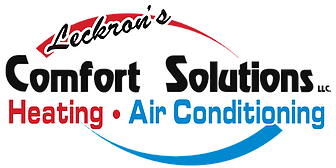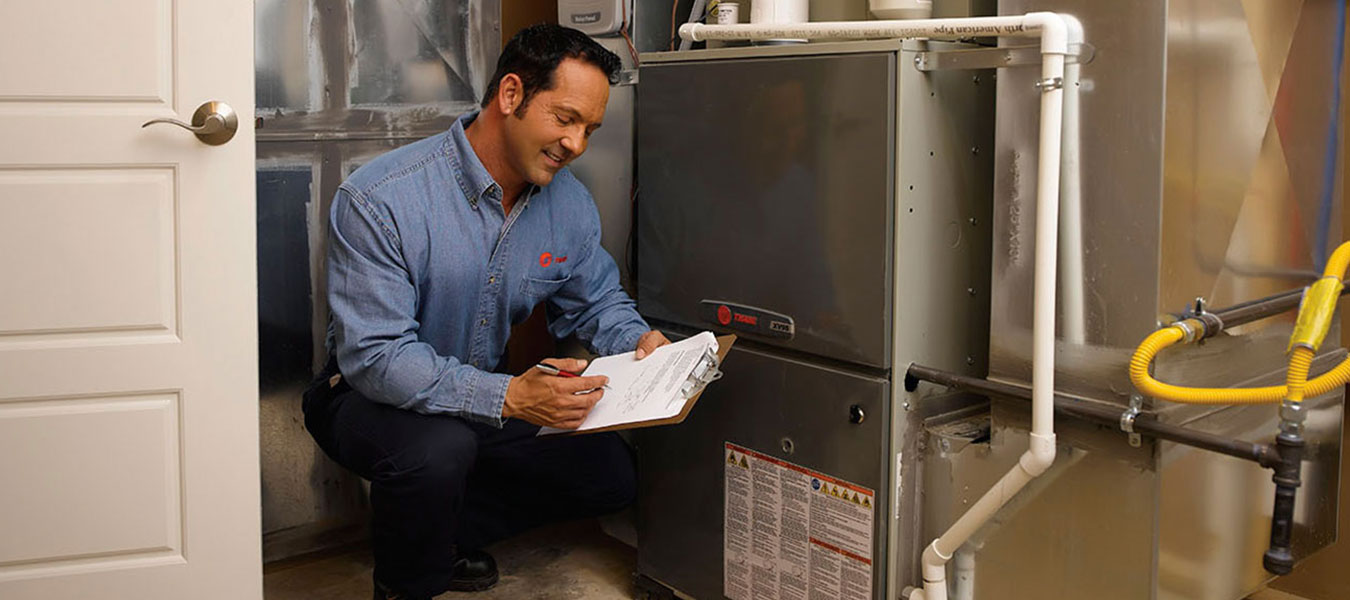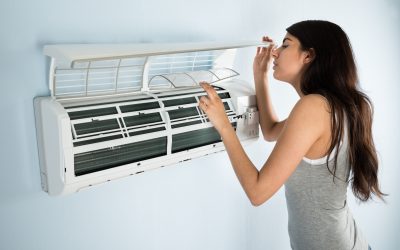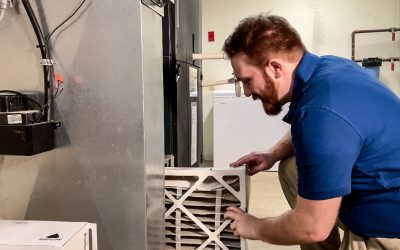Sweater weather has arrived in Pennsylvania. Time to crank up your furnace and combat the chill of the gusty November winds. What do you do when you crank up your heat and are greeted with clicks, clanks, and crashes?
With preventative maintenance, the worry about a faulty furnace amid a blustery fall day won’t be a concern. Regular HVAC maintenance lets you know your machine’s trouble spots and typical sights and sounds. When something looks awry, know how to troubleshoot your furnace and call in the professionals before potential problems snowball into a breakdown.
At Leckron’s Comfort Solutions, we believe homeowners should be empowered to make decisions on maintenance for their HVAC furnace. That’s why in this article, we share all the ins and outs of your furnace, including how it works, signs that you need maintenance, which tasks you can take on yourself, safety considerations, and when to call the professionals.
Understanding Your HVAC Furnace
In the past, furnaces used coal and wood to heat the air. Today, furnaces primarily run off natural gas, propane, or electricity. Some utilize a hybrid solution of gas and electricity. With proper and regular maintenance, gas furnaces generally last 10-15 years, oil-burning furnaces 20 years, and electric furnaces 20-30 years.
Before you troubleshoot or perform HVAC maintenance work, you should understand your system and its components. An incorrect diagnosis or repair can cause harm if you are not careful.
Main components of a furnace
The main components of your heating unit are the control system, gas valve, burners, heat exchanger, blower, and air ducts. Of course, there are many other aspects, such as filters, registers, and pilot lights, but when narrowing your system to the main components, these six are your standouts.
- Control System: the thermostat and electrical controls make up the control system. They tell your furnace when the air is too cold and that it needs to kick on to warm the room.
- Gas Valve: on gas-fueled furnaces, this valve allows gas to flow to the pilot light and burners.
- Burners: this is where the fire is generated by pulling gas from the gas line and igniting a fire.
- Heat Exchanger: the heated gasses are sent into a heat exchanger, warming the walls. Then, filtered air passes outside these warmed walls, absorbing the heat. The gasses inside the exchanger are then sent to a flue pipe, so they never mix with the filtered air you breathe.
- Blower: the blower is the component that blows air into your ductwork to travel to various rooms. A motor powers the blower. Both the blower and motor are held within a blower chamber.
- Air Ducts: the HVAC system has return ducts and supply ducts. The return ducts return air to your furnace to be filtered and warmed. The supply ducts supply the heated air to your home.
How HVAC furnaces work
Your thermostat has the job of telling your furnace when to kick on. When temperatures drop below a set point, the controller signals to your system that it is time to fire up.
In gas furnaces, the process starts with the gas valve turning on, and the burner sending warmed gas to the heat exchanger. Filtered air is heated by moving past the warmed walls of the heat exchanger and is then distributed to various rooms via supply air ducts. Return air ducts draw cold air into the furnace to be filtered and warmed. Flue pipes carry harmful exhaust gasses outside.
In an electric furnace, electric elements warm and exchange heat to the air. The warmed air is sent through the supply vents to the various rooms.
Types of furnaces
Most homes have one of four variations of furnaces: oil, gas, propane, or electric. Oil furnaces are most generally found in the northeastern states. They cost a bit less upfront but are less effective than gas furnaces. Today’s gas furnaces, on the other hand, are highly efficient. They are the most popular method of heating in the United States. When gas lines aren’t available, propane can be stored in tanks outside the home. Electric furnaces have a lower upfront cost, although the monthly bills could be higher in electric furnaces.
Signs Your Furnace Needs Maintenance
Generally, your furnace chugs along, doing its work without drawing your attention. It isn’t until there is a problem that you pay your system any mind. When this happens, take action to avoid a problem spiraling into a situation leading to replacement.
Warning signs of furnace issues
Knowing the signs of furnace issues helps you identify what is a problem worth calling in the pros versus which issues you can address yourself.
Cold Air
Your furnace should be warming your home. When the air from our vents is chilly, that signifies a problem. Failing motors are the most common reason cold air is delivered when you expect warm air. However, you also could have a pilot light or heat exchanger malfunction. These problems require the skilled hand of an HVAC tech to prevent them from snowballing into a bigger problem.
Loud Noises
Noise happens, and it is entirely natural for furnaces to have a sound. You should be concerned when this sound changes to something abnormal, such as rattling, banging, hissing, squealing, or popping. While it could be as simple as an overworked unit, it could also signify an emergency. Knowing the different sounds allows your chosen HVAC company to troubleshoot before stepping foot into your home.
Constant repairs
If you find yourself calling your HVAC company regularly, your furnace may be fizzling out. There’s no reason to be nickel and dimed by an old furnace on its last leg of life. Instead, talk to Leckron’s about replacing your system. With newer technology, you will likely save on your monthly bill while taking advantage of specials, rebates, and financing options.
Sickness
When your furnace begins to fail, it will be incapable of filtering air, adequately removing allergens, and risks building up carbon monoxide and harmful gasses in your home.
If your family shows increasing symptoms of illness, your HVAC system may be at fault. As some gasses can be dangerous, know the signs of carbon monoxide poisoning and contact a technician to troubleshoot your system.
Increased Energy Bills
A failing furnace has to work harder to do the same job. You see this increased energy in your monthly bills. Before calling in the pros, check your air filters. Dirty filters make it much harder to push the air through. If your filters are clean and the bills are still high, give Leckron’s a call to troubleshoot.
Safety concerns related to neglected maintenance
Because furnace problems can spiral out of control, it is crucial to address any problems quickly. Ignoring a faulty furnace could lead to a breakdown. If gasses escape, it can lead to a perilous situation.
Frozen Pipes
With a Pennsylvanian winter around the corner, the notion of frozen pipes is not a new one. A hard frost overnight can deliver a wake-up of frozen or burst pipes. This situation is particularly valid if your furnace breaks during an unexpected temperature drop. Staying ahead of any issues means you can sleep knowing you won’t have water issues on top of a freezing home in the morning.
Carbon Monoxide
The danger of carbon monoxide is that it is colorless and odorless. Without targeted focus, you may overlook the gas. Furnace components, such as the heat exchanger, risk cracking with extreme temperature changes… meaning gas could leak out.
Regular maintenance will catch these imperfections in your unit before they morph into a life-threatening situation. Any home with a furnace should install a carbon monoxide detector, checking it periodically.
House fires
When the internal components of your furnace are compromised, your home is at risk of fire. Pilot lights and worn wires create enough spark to start a fire, not to mention an explosion. Setting up a routine maintenance plan helps to catch these issues before they ignite.
DIY Maintenance Tasks
Not all furnace maintenance requires the hand of a professional. A few tasks take minimal effort, and you can complete them on your own without the additional cost of a professional.
Changing your air filter
Changing an air filter (LINK AIR FILTER ARTICLE) ensures your furnace is not overworking. Grab the correct-sized filter, flip off your furnace, locate the filter slot, and remove the old filter. Put the new filter in the same direction as the old one, paying close attention to the direction of the arrows. Screw on the cover, turn the furnace back on, and you are good to go.
Cleaning and lubricating furnace components
Before working on your furnace, kill the power. There is no reason to put yourself at risk when a simple circuit breaker flip could protect you. You’ll also want to cut off any gas going to the furnace by turning the valve ¼ of the way. The gas valve is often located near the fuel line.
Now that the power and gas are turned off do the following:
- Remove the furnace access doors and burner cover.
- Vacuum the burners and furnace using a shop vac, being extraordinarily careful around the wires and fan blades.
- Use a brush to help remove the excess dust.
- Clean the flame sensor rod carefully with a cloth.
Older furnaces need oil applied annually; however, newer furnaces do not. If you are unsure of your furnace type, consult your owner’s manual or check in with your HVAC technician. To apply oil, remove and clean the oil caps, apply 2-3 drops of lubricating oil, and then replace the caps.
Checking and cleaning vents and ducts
Generally, air duct cleaning should be left to the professionals. If done incorrectly, you can damage your unit or vents – especially if they are old.
If you want to trek ahead to tackle this task yourself, first verify duct cleaning is necessary. If your ductwork is properly sealed, you change your air filters regularly, and you clean your floor registers about every six months, you are likely fine to skip the cleaning. However, if there is a breakdown of sealant and tape on the ductwork, you’ve done renovation work, you notice animal nests or mold growth, or if the recommended routine maintenance has not occurred, you may be due for a duct cleaning.
To start the cleaning:
- Remove the covers for the air ducts, vents, and return-air grill plates.
- Cover the supply vents with paper towels by lifting the vent from the floor and placing a paper towel between the vent cover and the floor.
- Turn the thermostat to “fan on,” ensuring your heat and cool settings are set to off.
- If you have a brush, loosen up the dust buildup in your ductwork.
- Insert the vacuum hose as far into the duct as you can, turn the vacuum on, and allow the vacuum to suck up as much of the dust as it can.
- Repeat this with your supply ducts until you have cleaned all the ducts.
- Use a brush to remove buildup from the return ducts.
- Replace your air filter with a new filter.
Professional HVAC Maintenance
If you work with a reputable HVAC company, consider them partners. Their goal shouldn’t be to upsell you but to keep your family safe. When you call Leckron’s for routine maintenance, we inspect your machine to ensure nothing stands out as a potential problem.
Recommended frequency of professional maintenance
As a blanket rule, most HVAC companies recommend a maintenance checkup before the fall and the spring. As you prepare to switch from AC to heat, ensure any hiccups that may have happened over the off-season are addressed. Of course, your ultimate rule should be what keeps your unit in warranty, so be sure to check your owner’s manual.
What to expect during a professional maintenance visit
When we step into your home for a maintenance visit, our technician’s goal is to ensure your family has a safe heating environment during the cold season. As you know, Pennsylvania falls and winters are no joke. The last thing we want for you is to wake up shivering in the middle of a snow emergency.
We prevent this by emphasizing routine maintenance checks. If your system needs a tune-up, we have you covered. Leckron’s has an $89 tune-up special that includes a performance check and visual inspection for your unit.
Regular maintenance with Leckron’s includes:
- Checking for cracks or carbon monoxide leaks
- Inspecting your system for buildup or blockages
- Checking all electrical components
- Cleaning and adjusting the burners
- Checking the fan switch and air filters
- Ensuring there is no corrosion or damage
- Examining belts for wear
Our technicians are thoroughly trained to look for signs that lead to malfunction or dangerous situations.
Energy Efficiency and Cost Savings
A well-maintained furnace keeps energy efficiency up and monthly bills down. You can do your part to help with the environment while simultaneously keeping your hard-earned cash in your pocket.
Energy efficiency
More energy is required when your system works harder to do the same job. It makes logical sense that anything from a clogged filter to underperforming internal controls increases energy used. Regular maintenance can save up to 30% on your energy bill due to the decreased demand for energy, according to the US Department of Energy. This decrease in energy usage lowers your carbon footprint.
Cost savings through regular maintenance
Regular maintenance of your furnace prevents breakdowns. By taking care of your furnace, minor issues are caught before spiraling into significant repairs.
When you work with a company specializing in regular HVAC maintenance, they will know how to prevent the typical issues customarily seen with a lack of maintenance. Specific equipment allows them to detect problems homeowners cannot catch, preventing not just the expense of an unnecessary repair but also extending the life of your HVAC system. Furthermore, proper maintenance keeps your warranty compliant, so should something go wrong, you have coverage to fix the problem.
Safety Considerations
Working on your furnace is different from hanging a picture. There are real consequences if not done correctly. Knowing the risks involved lets you decide if continuing DIY maintenance is worth the risk.
Carbon monoxide (CO) concerns and prevention
Carbon monoxide poisoning in the home is sneaky and dangerous. The problem is that the gas is odorless and colorless, so you cannot detect it easily. Placing a carbon monoxide detector by your furnace is the best way to catch a carbon monoxide leak. Change the batteries yearly.
Furnaces that are improperly maintained or cracked are at risk of leaking carbon monoxide. If you have a gas furnace, turn the gas off when you shut off the power. Then, pay attention to the manufacturer’s instructions.
Gather your family and leave the house immediately if you smell gas or show signs of carbon monoxide poisoning. Then call Leckron’s Comfort Solutions ASAP. Never try to fix the gas leak yourself.
Fire safety and furnace maintenance
We use our basements for storage. From boxes to cans of paint, we often pile up items around the furnace. Keep laundry baskets, paper, cardboard, paint, and other flammable materials and liquids at least 10-15 feet away from your furnace to prevent an accidental ignition of flammable materials. Also, keep a smoke detector by your furnace and in multiple locations throughout your home so that if the unfortunate does happen, you can get help immediately. Like your carbon monoxide detector, check the batteries yearly.
Troubleshooting Common Furnace Issues
Not every furnace problem requires the hand of an HVAC technician. Knowing which of the most common problems you can solve on your own versus calling Leckron’s helps you to feel like you have some control over your home.
- Thermostat: when there is a faulty thermostat, your heat may not kick on, or it could cause short cycling. Check your battery first. If the thermostat seems not to cycle on according to the room temperature, give your technician a call.
- Filters: dirty filters cause more damage than meets the eye, from your system working harder to delivering poor air quality to your rooms and even causing your system to short-cycle. Keeping your filters changed on schedule is a simple and effective way to provide maintenance yourself.
- Pilot Light: if your pilot light is flickering, weak, or a strange color, it is a cue that something is wrong. If it is flickering or yellowish in hue, it could be a problem with carbon monoxide. Call Leckron’s as soon as possible to ensure there is nothing dangerous taking place.
- Heat Exchanger: if your heat exchanger is cracked, this is a technician call. Generally, a replacement of the heat exchanger is necessary.
- Blower Belt:if your belt is frayed or breaking, you may notice a high-pitched squeal. Give Leckron’s Comfort Solutions a call for replacement.
- Short or Over-Cycling: your system could be kicking on simply due to a dirty filter, but it could result from another issue. If, after changing your filter, your system is still short-cycling or seems never to stop running, call Leckron’s Comfort Solutions.
- Furnace Doesn’t Blow Air:this could be a clogged filter or blower. Ensure these are all clean. If you see any flashing, consult your owner’s manual. If clearing debris and changing the filter doesn’t do the trick, you are likely looking at a technician call.
- Ball Bearings: you will hear a scraping sound when these wear out. Quickly turn off your unit and call Leckron’s Comfort Solutions. The bearings need to be replaced so they do not cause damage to your system.
- Strange Noises: noises could be any number of reasons, from simply expanding and contracting to a faulty part. If you need clarification on the sounds, call your technician and explain what you hear. They may recommend a maintenance call to ensure there is no issue, especially if it has been a while since your system received any TLC.
Prioritize Maintenance
Making sure your system is well maintained isn’t a superfluous notion. It’s imperative to your family’s safety and your unit’s lifespan.
Take care of routine maintenance to keep your system operating at its best capacity. Then, schedule regular maintenance visits to prevent any emergency surprises.
“We are a first time customer of Leckron’s Comfort Solutions. Every aspect of the experience was excellent — from the initial phone call, to the tech, the timeliness and the professional manner with all communication. We’ll definitely be a repeat customer and would highly recommend them.” – David B., customer
Don’t let the fall and winter months leave you frosty. Prioritize your home this season by scheduling a checkup and routine maintenance. Give Leckron’s a call today!




